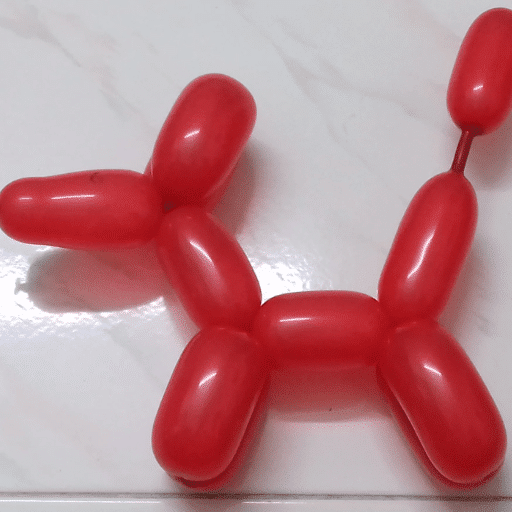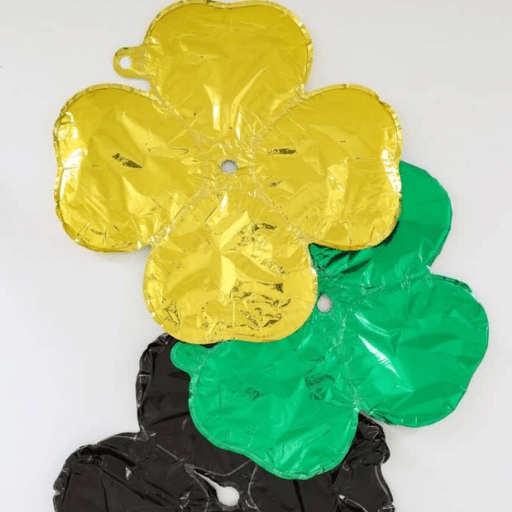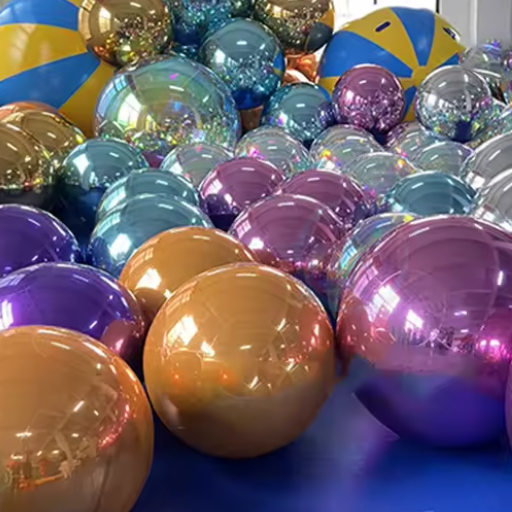Balloons add a feeling of joy and excitement to any celebration, be it a birthday party, wedding, or just any festive occasion. However, as bright and cheerful as these colors are, they are not forever. If you’ve ever wondered why some balloons seem to deflate after a shorter period and what factors influence the lifespan of a balloon, you’re not alone. The blog intends to demystify balloon deflation. We will understand how long balloons stay inflated, the difference between one balloon and another, and how to increase their floating time. Whether for planning an occasion or just out of sheer inquisitiveness, you will know how to make your balloons last long.
Introduction to Balloon Longevity

Several factors influence the longevity of a balloon, including its type, material, and surrounding environment. Latex balloons float for 12 to 24 hours with helium, whereas foil balloons may float for days or even weeks at a stretch. Environmental changes, such as sudden temperature fluctuations, direct sunlight, or wind exposure, accelerate the deflation of balloons. To increase balloon longevity, treat latex balloons with a sealant that impedes helium seepage and store all balloons in a cool, stable environment. You can use this knowledge to better plan and ensure that you keep balloons for special occasions.
The Importance of Balloon Types
Understanding the various balloon types available is essential if one wishes to select the right option for their specific need. Since balloon types offer specific properties, their appropriateness depends on factors such as durability, design, lifespan, and environmental impact. They are five common types of balloons:
Latex Balloons
- Latex balloons are biodegradable and eco-friendly since their raw material is natural rubber.
- They have a short lifespan of 12-24 hours, floating in helium.
- Used commonly in decorations and price-worthy for significant events.
Foil Balloons (Mylar Balloons)
- Made from metalized polyester that will reflect light.
- They remain afloat for a more extended period, from days to weeks, when filled with helium.
- They come in many shapes and forms, used primarily on personalized decorations.
Bubble Balloons
- It is made of clear, stretchy plastic with a unique see-through appeal.
- Highly durable and less prone to popping than latex balloons.
- The everyday use involves creative displays and customized messages.
Vinyl Balloons
- Made of strong vinyl, they are suitable for outdoor events because they can withstand weather changes.
- Usually filled with air and mounted on stands or poles.
- Suitable for long-term displays or promotional purposes.
Glow-in-the-Dark Balloons
- Coated with some material or with LED lights that give them a glowing effect in dim light.
- Great for night events, parties, or special themed decor.
- Made of latex or plastic, depending on the type of glow effect they carry.
By knowing the features of each balloon type, you will be able to make better decisions about your events and get the apt professional aesthetic and function.
Common Uses for Balloons
Balloons are all-around tools that can be used on many occasions, thanks to their affordability, types, and charm. Below are some of the most popular usages of balloons, along with recent facts and figures:
Celebrations and Parties
Balloons provide a festive backdrop for special occasions like birthdays, weddings, anniversaries, and more. A new height has come in event decor, as shown by a 37% surge in the Google search for “birthday balloon ideas” in the last year alone. Customers have the option of custom and themed balloons for parties.
Promotions and Advertising
Using balloons for promotion includes grand openings, sales events, and product launches. Balloons often carry logos or slogans, and they are effective at capturing attention. A study reported that colorful arrangements, especially those used outdoors with balloons, were able to increase foot traffic by as much as 25% during promotional activities.
Corporate Events and Conferences
Balloons are often used to adorn corporate events, adding a stylish touch to seminars, team-building activities, or product showcases. Recently, eco-friendly balloon décor has become increasingly in demand at corporate events, with companies prioritizing sustainability as a core corporate responsibility. Balloon walls and structures are the preferred choice for providing photo opportunities for branding.
Event Milestones and Gender Reveals
Unusual balloon installations have become increasingly popular for celebrations, including gender reveal parties. Gender reveal balloons, which release colored confetti upon explosion, are now among the top-selling balloon types on e-commerce platforms. Worldwide search interest for “gender reveal balloons” rose 45% in 2023.
Ceremonial Releases
During ceremonies, balloons are released to symbolize hope, memory, or celebration. Nonetheless, given the environmental concerns, interest has now shifted on biodegradable balloons, or virtual balloon releases to retain symbolism while curbing ecological impact.
Decorative Art and Sculpture
Balloon arts and sculptures are finding their way to the big stage in significant events and festivals. Now, professional balloon artists are designing everything, ranging from floral decorations to life-size sculptures. Moreover, there has been a 28% increase in searches for terms like “balloon sculpture ideas” on Google Trends, highlighting the growing enthusiasm for this form of creative expression.
Educational and Scientific
Balloons are often used to demonstrate principles and experiments for physics, chemistry, and aerodynamics. For instance, in a classic experiment, balloons are used to show how air pressure, propulsion, or static electricity systems work in classrooms and science fairs.
Health and Therapeutic Use
Balloon activities are also therapeutic applications, especially for children. Balloon games are used to develop motor skills, coordination, and balance in a fun and engaging way. The Centers that implement therapeutic plans for kids report using balloons in 60% of their sensory activities.
How Long Does It Take Balloons to Deflate?
The time it takes for balloons to lose gas depends on their material and the surrounding environment. A typical case would be a latex balloon deflating in 12-24 hours, which is relatively speedy compared to a foil balloon, as it can remain afloat for several days to even weeks.
Balloon Lifespan Comparison
| Balloon Type | Helium Inflation Lifespan | Air Inflation Lifespan |
|---|---|---|
| Latex Balloons | 12-24 hours | 3-7 days |
| Foil Balloons | 3-5 days (up to 2 weeks) | Weeks to months |
| Bubble Balloons | 2-4 weeks | Not commonly used for air |
| Cloudbuster Balloons | 3-5 days | Not widely used for air |
Factors Affecting How Long Balloons Last

Type of Material
Latex balloons deflate faster than foil ones. This is because latex is a porous material that allows helium or air to escape more quickly, whereas foil balloons retain very little gas through their material and can float around for days or weeks.
Gas Used
Because helium molecules are smaller, the gas escapes faster than air; thus, helium-based balloons deflate sooner than those filled with air.
Environment
Temperature and sunlight exposure can also affect longevity. Heat aids the expansion and weakening of the balloon materials, while the contractive effects of cold on helium lessen its flotation time.
Environmental Conditions
Environmental conditions, such as temperature, humidity, and sunlight, affect the lifespan of the balloon material and the contents inside the balloon, specifically whether it contains helium or air.
Temperature
Temperature conditions extensively test balloon performance. High temperatures, as studies have shown, cause expansion in balloon materials like latex, making them prone to bursting. Additionally, excessive heat causes helium to expand, leading to over-inflation and potential bursting. In contrast, when the temperature is low, helium contracts, thus reducing the balloon’s buoyancy and increasing the rate at which it deflates. Studies also indicate that in extreme cold conditions, helium-filled balloons lose approximately 5-10% of their lift compared to more moderate temperatures.
Humidity
High humidity levels also wreak havoc on balloon materials, making latex balloons more prone to softening and popping. Tests demonstrated that balloons placed in atmospheres with relative humidity above 80% deteriorate approximately 20% faster than those in atmospheres with lower relative humidity. This effect on foil balloons is hardly noticeable, given that metallic material is less permeable and far more resistant to moisture.
Sunlight Exposure
Sunlight causes the quick breakdown of balloon materials in the case of latex balloons. Solar radiation, through UV rays, affects the molecular structure of latex materials, dramatically reducing their lifespan. It has been experimentally verified that latex balloons kept in the direct sunlight may start weakening within an hour while those that are kept in the shade may live up to 10 times longer. Thus, the foil balloons, represented by a much more rigid material, remain susceptible to degradation with exposure to intense sunlight.
Preparing for Good Conditions
In general, it is best to inflate balloons in a temperature-controlled environment and keep them shielded from direct sunlight. Applying a balloon treatment or coating that slows down helium or air loss further increases their life. By understanding and mitigating the adverse effects of environmental conditions, balloons can remain in excellent condition for a longer period, providing an added boost to the success of any event or display. For instance, balloons in indoor events can remain inflated for 12 to 24 hours without significant deflation, provided the temperature and humidity are stable. However, outdoor events require extra caution.
Balloon Size and Quality
The size of the balloons matters when it comes to how well they perform, the amount of time they last, and their suitability for the various applications. High-quality balloons manufactured from durable materials tend to resist environmental stressors and hold gases longer. Here are some details and characteristics relevant to size and quality of a balloon:
- Material Used: Latex balloons are biodegradable and stretchy, whereas Mylar or foil balloons are made to be stronger and less porous but are not biodegradable. Choose a material relevant to the event or display at hand.
- Size Variations: Balloons are available in several sizes, usually measured in inches or centimeters when fully inflated. Most commonly, small being 5 inches, medium 11 to 12 inches, and large being from 24 to 36 inches in diameter to cater to varied decoration needs.
- Thickness (Mil) of the Material: The thickness of a balloon is quite important in situations with helium gas or air. The thicker the balloon, the lower the chance of leakage, and the more apt the balloon would be for outdoor use where temperatures change.
- Quality of Seams: Good-quality balloons have robust seams that provide perfect sealing, capable of resisting bursting from inflation or handling. If the seams are poorly made, the balloon will usually fail prematurely.
- Environmental Resistance: UV-inhibited balloons withstand outdoor use for extended periods, as they prevent discoloration and degradation.
Inflation Method and Material
During balloon inflation, the method and tools used must be suitable to yield the desired results and ensure safety. Some common methods drange from epending on specific situations:
Manual Inflation
Balloons are manually inflated by attaching a hand pump or blowing air using one’s own mouth. This method is inexpensive and highly practical for a small arrangement, but is laborious and less efficient when it comes to big set-ups where thousands of balloons are to be inflated.
Electric or Battery-Operated Pumps
When having to deal with a large number of balloons, electric or battery-operated pumps give the best solutions for inflammation and disposal. This massively curtails the amount of time and energy involved, thus, making these pumps quite popular among professional decorators and event planners. For instance, an average electric pump inflates about 30 – 50 balloons in 5 minutes.
Helium Inflation
While helium inflation allows the balloons to float and gracefully decorate social parties and events, the rare nature of helium combined with global supply shortfalls has, in recent years, provoked price hikes. Over the last decade, helium’s price has risen by nearly 50%, forcing it to be used sparingly, primarily for select high-value decorations.
Air Inflation for Stability
Balloons inflated with air typically do not float and are generally used in structures such as arches or garlands. At least in an outdoor context, they are more cost-efficient and more stable than helium balloons, since wind could still mess with floating balloons for quite some time.
Balloon Material Considerations
Latex Balloons
Latex is the most common balloon material due to its cheapness and availability in varying sizes and colors. Most people prefer biodegradable latex balloons as they break down within a short period when left in the environment, thereby minimizing pollution. On the other hand, cheap latex balloons are prone to punctures and uneven inflation.
Mylar (Foil) Balloons
Made of metallic plastic film, Mylar balloons provide for shiny, eye-catching surfaces. They have much more durability as compared to those of latex balloons and can hold helium for quite a bit of time, active up to a week when in the best of conditions. However, Mylar balloons are not biodegradable, and recycling them can go far in preventing further environmental degradation.
How Long Do Balloons Stay Inflated?

The time for which a balloon remains inflated will depend on both the type of balloon and how it is filled. A balloon filled with air may generally stay inflated for as much as a week, while for a latex balloon filled with helium, it usually remains in the air from eight to twelve hours. On the other hand, due to the non-porous nature of the material, Mylar balloons tend to remain inflated for several days to an entire week when filled with helium. That aside, there are other factors such as temperature, humidity, and presence of sunlight that may also affect how long the balloons remain inflated. Consequently, for maximum retention time, balloons ought to be stored indoors, preferably away from direct sunlight.
Latex Balloons: Expected Duration
Latex balloons will, however, vary in the period of inflation based on the gas used in them and also depending on environmental factors. Since filled with normal air, latex balloons can last from under 12 hours to one week. Their longevity principally depends on the quality of latex used and also on if they were treated further with an anti-deflation agent such as Hi-Float. Untreated air-filled latex balloons may remain fully inflated for only one or two days.
Helium-filled latex balloons, on the other hand, have much shorter float times because of the smaller helium molecules, which seep faster through the porous latex. Usually, helium-filled latex balloons float for about 8 to 12 hours. Considering the Hi-Float treatment, the float time can be further extended to 24 hours or a day or two if the conditions are excellent. Maintenance of temperature and humidity is very favorable for the latex balloons, as it heavily determines their cell life. Exposure to heat or sunlight accelerates the escape of helium, significantly reducing its float time. Therefore, to maintain float time for the longest possible period, helium-filled balloons should be kept in a cool room away from direct sunlight or any source of heat.
Helium Balloons: Duration and Tips
The time a helium balloon stays aloft depends on several critical elements, including the type of balloon, the surrounding conditions, and any treatments applied to maintain the helium inside. Untreated Latex balloons are usually able to float for 8 to 12 hours in normal conditions. With the use of Hi-Float or a comparable treatment, however, it is possible to achieve float times of 24-48 hours and possibly longer with expert use. Foil or Mylar balloons are far sturdier and, if properly stored, can stay afloat for 3 to 5 days, or even up to a couple of weeks.
Data on Common Balloon Longevity
- Latex Balloons are expected to float for 8-12 hours unless treated with Hi-Float, which can extend their lifespan to up to 48 hours.
- Mylar balloon would float for 3-5 days straight, and could last a few more weeks as well.
Environmental Impact on Float Time
Environmental factors, such as temperature, Humidity, or Heat Properties, influence the lifespan of helium balloons. High temperatures accelerate the expansion and increased escape of the helium, resulting in a reduction in float time. Cold weather would slow the loss of helium, while a temporary deflation of the balloon occurs due to contraction.
Mylar Balloons: Longevity Insights
Mylar balloons have other names, such as foil-filled balloons, due to their non-porous material and metallic coating. The general time of appearance indoors can be as long as 2-3 weeks if the plants are kept in ideal conditions. However, environmental factors will significantly impact the length of their lives.
Factors Affecting Mylar Balloon Life Span:
Helium Retention: The tightly sealed Mylar prevents helium from quickly escaping; therefore, Mylar balloons will float much longer than their latex counterparts. Most helium lasts between 3 and 5 days before noticeable decay, while Mylar balloons filled with air may retain their shape for a couple of weeks or even months.
Temperature Sensitivity: Extended temperature extremes may slightly affect the material; i.e., when exposed to cold air, Mylar balloons start to deflate as they contract, and they will expand again if returned to a warm environment. In extremely high temperatures, the opposite will occur, causing overexpansion and increasing the risk of bursting.
Storage and Reuse: Mylar balloons can be reused if deflated carefully. Keeping them stored flat, away from sunlight or sharp edges, will lengthen their period of usefulness for any potential future occasion.
Usefulness of Data or Statistics:
- Mylar Balloon holds helium, according to some event decorators and retailers, at 1-2% a day under normal room conditions.
- Studies reveal that colder settings (below 50°F) may cause Mylar balloons to lose helium at a possibly 25% faster rate, whereas temperatures above 95°F may accelerate material degradation.
- A well-sealed Mylar balloon filled with normal air, rather than helium, has been observed to maintain its shape for an impressive 3-4 months, provided it was kept away from anything that could cause it to puncture.
Extending the Life of Your Balloons

The following practical tips for extending the lifespan of your Mylar balloons are:
- 1
Keep Balloons at a Stable Temperature
Do not subject balloons to extreme heat or cold. High temperatures can render the material weak and degraded, while cold temperatures can contract it, leading to deflation. A perfect modus is having it stored and displayed at a comfortable range of 68°F to 78°F. - 2
Avoid Direct Sunlight
The longer exposure of ultraviolet rays is rendering faster material degradation and color fading. Place your balloons in either shade or indoors to maintain their look for longer. - 3
Use Quality Seals
Ensure all balloons are kept tightly sealed to avoid any air or helium leakage from inside. A high-quality self-sealing valve or heat seal can make a significant difference in how long a balloon can maintain its shape. - 4
Handle with Care
Avoid contact with sharp objects and rough surfaces; friction may also cause punctures or tears on the balloons. When not in use, balloons must be stored in a safe place. - 5
Inflate to the Correct Level
Over-inflating will increase the likelihood of balloons bursting, whilst under-inflating will only cause wrinkles on the balloons. Inflate balloons to the recommended volume for a better appearance and longer-lasting balloons. Also, the use of a pump with a pressure gauge is advisable.
Best Practices for Inflation
When filling Mylar balloons, taking the right procedure in consideration would bring the best results, prolonging life, and giving great looks to the balloons. Here are some detailed best practices as per the newest insights:
Choose Your Way of Inflation
With helium, the balloon floats and is excellent for entertainment, while air keeps the balloon on the floor as an ornament. Helium-inflated balloons have varying durations of 1 or 2 weeks, depending on conditions and quality, while air-filled balloons last several weeks.
Carefully Watch Inflation
The primary reason balloons pop is over-inflation. It’s often commented that a Mylar balloon should be inflated to about 90-95% of its total capacity. When properly inflated, a fully-inflated Mylar balloon will feel firm but won’t stretch and strain. This can be checked by using a balloon sizer or an automatic inflator.
Consider Temperature and Altitude
Temperature changes cause Mylar balloons to undergo volume changes. For example, a balloon kept in direct sunlight, warming it up, can suddenly burst due to heat-induced expansion. At low temperatures, balloons feel very thin and do temporarily deflate due to gas contraction. There is also an altitude effect, with changes in inflation pressure and float-time duration.
Have High-Quality Helium or Air
The purity of the helium significantly affects the float time. While many sources claim that 99.99 percent pure helium extends float duration significantly when compared to less pure grades, air must be dry if using it to maintain the structural integrity of the Mylar material.
Seal Properly
Mylar balloons usually come with self-sealing valves; however, these can fail in some cases if not handled carefully. Seal the entrance well after inflation; otherwise, helium or air will escape with time. You can even secure the seal additional times using glue or clippers.
Storage Tips to Prevent Deflation
Mylar balloons are one of the most beautiful giveaways. To keep the balloon inflated and looking nice for as long as possible, proper storage has to be exercised. Here are five detailed tips that will definitely help in deflation:
- Store in a Cool, Dry Place: Temperature extremes cause the helium or air inside to expand or contract, which can cause the balloon to go flat. The ideal temperature for seating is approximately 70°F (21°C).
- Keep Away From Sunlight: Prolonged exposure to sunlight heats the balloon, weakening it and allowing air to seep through. The balloons should not be kept near windows or in places with heavy UV exposure.
- Away from Anything Sharp: Before storage, the environment should be checked for sharp objects, such as nails, pins, or even slightly rough surfaces. If something as minor as a slight puncture occurs on a balloon, it will slowly, possibly immediately on occasion, cause the balloon to deflate.
- Deflating Balloons for Long-Term Storage: When the balloons are not in use, deflating and storing them flat helps maintain the integrity of the materials. This would prevent the seams from being stressed, increasing the ability to reuse them.
- Use Airtight Containers: Store the balloons in an airtight plastic container or plastic bag to protect them from dust, dirt, and humidity. This also serves as protection, preventing accidental damage along the way.
Using Balloon Treatments for Longevity
I truly believe that balloon treatments have some really good uses in desire for longevity. For instance, a product such as Hi-Float coating inside latex balloons will prevent the helium from leaking out, thus sometimes extending float time for several days. Applying the product really is very simple: Just drop in the solution, tilt and rotate the balloon so that the inside is evenly coated by the solution, then proceed with usual inflation. For best results on Mylar balloons, make sure that you get them fully inflated and though overfilling will stretch and deform the plastic material. These little things go an awfully long way in lept lined up.
Frequently Asked Questions (FAQ)
How long do helium balloons last?
The usual duration for a helium balloon to be afloat is between 8 hours and 12 hours. Size of the balloon and the kind of material it is made from, such as latex or foil, affect this time span. The rate at which helium molecules intermingle through the material liberates the helium from balloons faster than air that comes in through this method.
How about if latex arrived first: does a latex balloon last longer than a foil one?
Typically, foil balloons last a lot longer than latex ones. Latex balloons generally stay inflated for a few hours to a day. In contrast, foil or mylar balloons can stay afloat for several days or even weeks, as they are made of non-porous material through which air cannot escape quickly.
How long does an air-filled latex balloon last?
Air-filled latex balloons can stay inflated for several days to weeks, depending on the conditions. The air does not escape as quickly as helium does inside the balloon, thus enabling these balloons to maintain their shape and fullness over a longer period.
What deflates balloons overnight?
Temperature change and the porous nature of latex are responsible for the nighttime deflation. Cooling of the air inside the balloon would cause the balloon to shrink. Any puncture or weak area would allow air to pass through, thus deflating.
Do helium balloons last longer indoors?
Helium balloons tend to last longer indoors compared to outdoors. A temperature-stable and wind-free indoor environment keeps the helium inside the balloon for longer. Ideally, they will last up to 12 hours inside.
Involving a balloon’s longevity, how does the material factor in?
The role played by the material is quite paramount in determining how long a balloon will last. Since latex balloons are more porous and allow the air to escape faster, foil or mylar balloons consist of non-porous materials that retain helium or air for longer periods and often last several days.
How can I increase the lifespan of helium balloons?
To increase the life of helium-filled balloons, using a product called Hi-Float can be highly effective. This product coats the inside of the balloons, preventing the escape of helium molecules. Keep the balloons in a cool, dry place away from direct sunlight, which should also increase the period during which they will float.
How long do latex balloons last when filled with regular air?
Latex balloons filled with regular air can last anything between 12 hours to a few days, depending on the atmospheric conditions prevalent around them. When exposed to cooler temperatures, they tend to last for longer periods; however, heating will hasten the deflation process.
Do large balloons last longer?
Yes, large balloons tend to last longer than smaller ones. The bigger the volume, the more air or helium is trapped inside, which slows down the deflation time. However, material and balloon type are still very much precious factors determining how long a balloon will stay crisp.
Key Takeaway
Understanding balloon deflation helps you make informed choices for your events. By selecting the right balloon type, managing environmental conditions, and following proper storage techniques, you can significantly extend balloon life and create memorable celebrations that last longer.









